
The spaghetti Western is a broad subgenre of Western films produced in Europe. It emerged in the mid-1960s in the wake of Sergio Leone's filmmaking style and international box-office success. The term was used by foreign critics because most of these Westerns were produced and directed by Italians.

Four of the Apocalypse is a 1975 Italian spaghetti Western film directed by Lucio Fulci and starring Fabio Testi, Tomas Milian, Lynne Frederick and Michael J. Pollard.

Tomas Milian was a Cuban-born actor and singer with American and Italian citizenship, known for the emotional intensity and humor he brought to starring roles in European genre films.
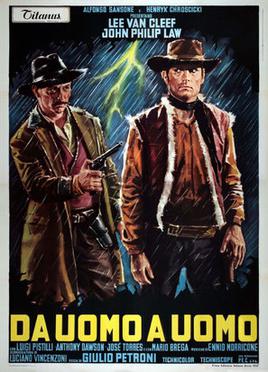
Death Rides a Horse is a 1967 Italian Spaghetti Western directed by Giulio Petroni, written by Luciano Vincenzoni and starring Lee Van Cleef and John Phillip Law.
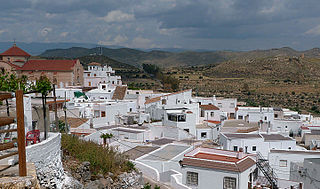
Lucainena de las Torres is a municipality of Almería province, in the autonomous community of Andalusia, Spain. Lucainena de las Torres belongs to the association "The Most Beautiful Villages of Spain".

George Hilton was a Uruguayan actor well known for his many Spaghetti Western performances. Sometimes credited as Jorge Hilton, he appeared in over 20 Euro-Westerns as well as several giallo and action films.
El Macho is a 1977 Italian-Argentine Spaghetti Western film written and directed by Marcello Andrei and starring Carlos Monzón, George Hilton, Malisa Longo and Susana Giménez.

The Savage Guns is a 1961 Eurowestern film, an international co-production by British and Spanish producers. Based on a specially commissioned screenplay, The San Siado Killings, written by Peter R. Newman and directed by Michael Carreras, the film is credited as the first traditional Spaghetti Western.
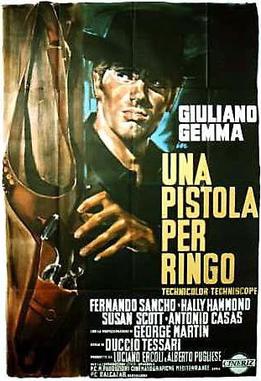
A Pistol for Ringo is a 1965 Spaghetti Western, a joint Italian and Spanish production. Originally written and directed by Duccio Tessari, the film's success led to a follow-up, The Return of Ringo, later that year, which, in spite of sharing the same name for the titular character, is not a sequel to this film and deals with an entirely new character and storyline.

His Name Was King is a 1971 Italian Western film directed by Giancarlo Romitelli and starring Richard Harrison and Klaus Kinski.
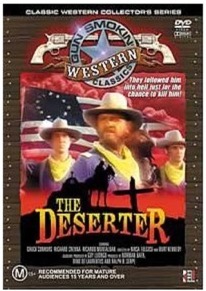
The Deserter, also known as The S.O.B.s and The Devil's Backbone is a 1970 Italian-Yugoslav American international co-production Western film produced by Dino De Laurentiis. It was directed by Burt Kennedy and written by Clair Huffaker.
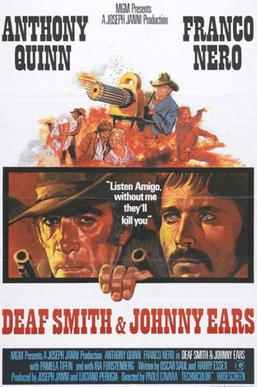
Deaf Smith & Johnny Ears, also known as Los Amigos, is a 1973 Spaghetti Western film starring Anthony Quinn and Franco Nero. The film is loosely based on the life of Deaf Smith, with direction by Paolo Cavara.

Silver Saddle is a 1978 spaghetti Western. It is the third and final western directed by Lucio Fulci and one of the last spaghetti Westerns to be produced by a European studio. The film was based on an original story written by screenwriter Adriano Bolzoni and directed by Fulci for the Italian studio Rizzoli Film Productions.
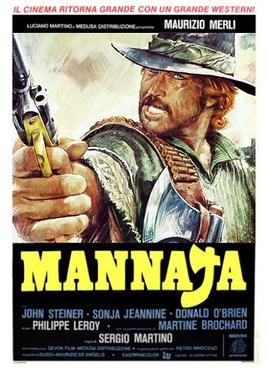
Mannaja is an Italian 1977 Spaghetti Western film directed by Sergio Martino. The main role, Blade, is played by Maurizio Merli. Other central roles are played by John Steiner, Sonja Jeannine, Donald O'Brien, Philippe Leroy and Martine Brochard.

A Reason to Live, a Reason to Die is a 1972 Technicolor Italian spaghetti Western movie starring James Coburn, Bud Spencer and Telly Savalas.
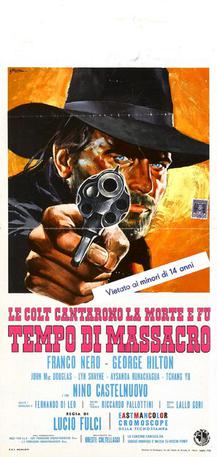
Massacre Time is a 1966 Italian Spaghetti Western film starring Franco Nero and George Hilton.

Django is a fictional character who appears in a number of Spaghetti Western films. Originally played by Franco Nero in the 1966 Italian film of the same name by Sergio Corbucci, he has appeared in 31 films since then. Especially outside of the genre's home country Italy, mainly Germany, countless releases have been retitled in the wake of the original film's enormous success.

A Sky Full of Stars for a Roof is a 1968 Italian Spaghetti Western comedy film.

Django Shoots First is an Italian Spaghetti Western film directed by Alberto De Martino.

Per il gusto di uccidere is the 1966 Italian Spaghetti Western film debut directed by Tonino Valerii. It is also the first film to use the camera system known as 2P. It was filmed in Almería. It is produced by Francesco Genesi, Vincenzo Genesi, Daniele Senatore, Stefano Melpignano and Jose Lopez Moreno, scored by Nico Massi and edited by Rosa G. Salgado.



















